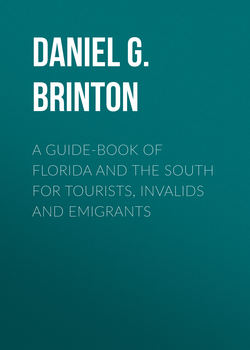Читать книгу A Guide-Book of Florida and the South for Tourists, Invalids and Emigrants - Brinton Daniel Garrison - Страница 9
PART II.
FLORIDA
1. HISTORICAL
ОглавлениеLong before Columbus saw
“the dashing,
Silver-flashing,
Surges of San Salvador,”
a rumor was abroad among the natives of the Bahamas, of Cuba, and even of Yucatan and Honduras, that in a land to the north was a fountain of water, whose crystal waves restored health to the sick, and youth to the aged. Many of the credulous islanders, forsaking their homes, ventured in their frail canoes on the currents of the Gulf, and never returning, were supposed to be detained by the delights of that land of perennial youth.
This ancient fame still clings to the peninsula. The tide of wanderers in search of the healing and rejuvenating waters still sets thitherward, and, with better fate than of yore, many an one now returns to his own, restored to vigor and life. Intelligence now endorses what superstition long believed.
The country received its pretty and appropriate name, Terra florida, the Flowery Land, from Juan Ponce de Leon, who also has the credit of being its discoverer. He first saw its shores on Easter Sunday, March 27, 1513 – not 1512, as all the text books have it, as on that year Easter Sunday came on April 20th.
At that time it was inhabited by a number of wild tribes, included in two families, the Timucuas, who dwelt on the lower St. John, and the Chahta-Muskokis, who possessed the rest of the country. In later times, the latter were displaced by others of the same stock known as Seminoles (isti semoli, wild men, or strangers). A remnant of these still exist, several hundred in number, living on and around Lake Okee-chobee, in the same state of incorrigible savagery that they ever were, but now undisturbed and peaceful.
The remains of the primitive inhabitants are abundant over the Peninsula. Along the sea shores and water courses are numerous heaps of shells, bones and pottery, vestiges of once populous villages; small piles of earth and “old fields” in the interior still witness to their agricultural character; and large mounds from ten to twenty-five feet in height filled with human bones testify to the pious regard they felt toward their departed relatives, and the care with which, in accordance with the traditions of their race, they preserved the skeletons of the dead. As for those “highways” and “artificial lakes” which the botanist Bartram thought he saw on the St. John river, they have not been visible to less enthusiastic eyes. Mounds of stones, of large size and enigmatic origin, have also been found (Prof. Jeffries Wyman).
For half a century after its discovery, no European power attempted to found a colony in Florida. Then, in 1562, the celebrated French Huguenot, Admiral de Coligny, sent over a number of his own faith and nation, who erected a fort near the mouth of the St. John. As they were upon Spanish territory, to which they had no right, and were peculiarly odious to the Spanish temper by their religion, they met an early and disastrous fate. They were attacked and routed in 1565 by a detatchment of Spaniards under the command of Pedro Menendez de Aviles, a soldier of distinction. The circumstance was not characterized by any greater atrocity than was customary on both sides in the religious wars of the sixteenth century, but it has been a text for much bitter writing since, and was revenged a few years after by a similar massacre by a French Protestant, Dominique de Gourgues, and a party of Huguenots.
Pedro Menendez established at once (1565) the city of St. Augustine and showed himself a capable officer. Under the rule of his successors the Spanish sway gradually extended over the islands of the eastern coast, and the region of middle Florida. The towns of St. Marks and Pensacola were founded on the western coast, and several of the native tribes were converted to Christianity.
This prosperity was rudely interrupted in the first decade of the eighteenth century by the inroads of the Creek Indians, instigated and directed by the English settlers of South Carolina. The churches were burned, the converts killed or scattered, the plantations destroyed, and the priests driven to the seaport towns.
The colony languished under the rule of Spain until, in 1763, it was ceded to Great Britain. Some life was then instilled into it. Several colonies were planted on the St. John river and the sea coast, and a small garrison stationed at St. Marks.
In 1770 it reverted once more to Spain, under whose rule it remained in an uneasy condition until 1821, when it was purchased by the United States for the sum of five million dollars. Gen. Andrew Jackson was the first Governor, and treated the old inhabitants in his usual summary manner. In 1824 the seat of government was fixed at Tallahassee, the site of an old Indian town.
At the time of the purchase there were about 4,000 Indians and refugee negroes scattered over the territory. These very soon manifested that jealousy of their rights, and resentment against the whites, which have ever since been their characteristics. From the time of the cession until the out-break of our civil struggle, the soil of Florida was the scene of one almost continual border war. The natives gave ground very slowly, and it was estimated that for every one of them killed or banished beyond the Mississippi by our armies, the general government expended ten thousand dollars.
